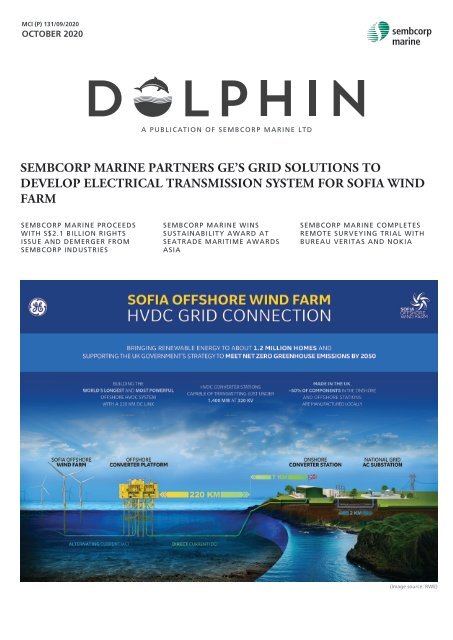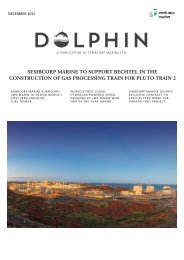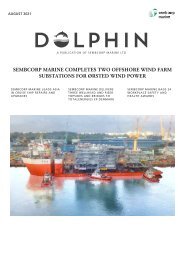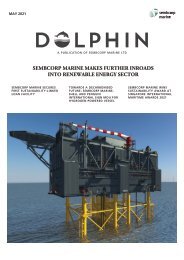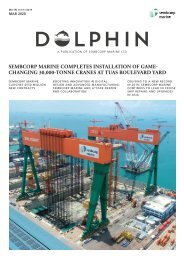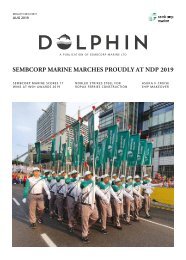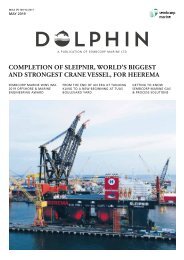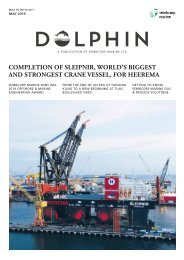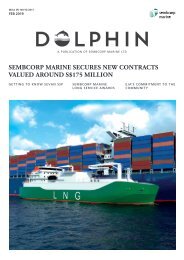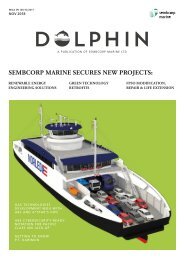Dolphin October 2020
Create successful ePaper yourself
Turn your PDF publications into a flip-book with our unique Google optimized e-Paper software.
MCI (P) 131/09/<strong>2020</strong><br />
OCTOBER <strong>2020</strong><br />
SEMBCORP MARINE PARTNERS GE’S GRID SOLUTIONS TO<br />
DEVELOP ELECTRICAL TRANSMISSION SYSTEM FOR SOFIA WIND<br />
FARM<br />
SEMBCORP MARINE PROCEEDS<br />
WITH S$2.1 BILLION RIGHTS<br />
ISSUE AND DEMERGER FROM<br />
SEMBCORP INDUSTRIES<br />
SEMBCORP MARINE WINS<br />
SUSTAINABILITY AWARD AT<br />
SEATRADE MARITIME AWARDS<br />
ASIA<br />
SEMBCORP MARINE COMPLETES<br />
REMOTE SURVEYING TRIAL WITH<br />
BUREAU VERITAS AND NOKIA<br />
Suhaimi Bin Yusof<br />
(Image source: RWE)
CONTENTS<br />
DOLPHIN is published by<br />
Sembcorp Marine Corporate Communications.<br />
Sembcorp Marine Ltd<br />
80 Tuas South Boulevard,<br />
Singapore 637051<br />
Tel: (65) 6265 1766<br />
Registration no. 196300098Z<br />
EDITORIAL<br />
Editorial Committee<br />
Lin Daoyi<br />
Joleen Seam<br />
Nirmal Vineeth Menon<br />
Wang Hui Ping<br />
NEWS UPDATES<br />
03<br />
04<br />
05<br />
06<br />
06<br />
Sembcorp Marine Partners GE’s Grid Solutions To<br />
Develop Electrical Transmission System For Sofia Wind<br />
Farm<br />
Sembcorp Marine Proceeds With S$2.1 Billion Rights Issue<br />
And Demerger From Sembcorp Industries<br />
Sembcorp Marine Wins Sustainability Award At Seatrade<br />
Maritime Awards Asia<br />
Sembcorp Marine President & CEO Appointed Co-chair<br />
Of International Advisory Panel On Maritime<br />
Decarbonisation<br />
Sembcorp Marine And Partners Donate Face Masks And<br />
Hand Sanitisers To Frontline Healthcare Workers In Batam<br />
INNOVATION AND KNOWLEDGE<br />
Contributors<br />
Herman Bin Amin<br />
Ooi Yeong Lih<br />
Suhaimi Bin Yusof<br />
Ong Mei Ting Alicia<br />
Wee Keng Wee<br />
07 Sembcorp Marine Completes Remote Surveying Trial with<br />
Bureau Veritas and Nokia<br />
08<br />
From Innovative Ideas To Valuable Business Assets:<br />
Managing Sembcorp Marine’s Intellectual Property (IP)<br />
For Sustainable Growth<br />
09 Sembcorp Marine Subsidiary LMG Marin Spearheads<br />
Zero-Emission Vessel Development<br />
10 The Value Of Problem-Solving And Critical Thinking<br />
Skills<br />
HEALTH AND SAFETY<br />
CONTACT US<br />
12<br />
COVID-19 Safe Management Measures At Sembcorp<br />
Marine Tuas Boulevard Yard And Tanjong Kling Yard<br />
We want to hear from you. If you have any<br />
comments about the articles in this issue,<br />
ideas for future issues, or requests related to<br />
DOLPHIN mailing list, please send them to<br />
corp.comms@sembmarine.com.<br />
No part of this newsletter may be reproduced or<br />
transmitted by any means or stored in any information<br />
storage or retrieval system without Sembcorp Marine’s<br />
written permission.<br />
On the cover - Sofia Offshore Wind Farm HVDC Grid Connection<br />
(Image source: RWE)
NEWS UPDATES<br />
SEMBCORP MARINE PARTNERS GE’S GRID SOLUTIONS TO<br />
DEVELOP ELECTRICAL TRANSMISSION SYSTEM FOR SOFIA<br />
WIND FARM<br />
Samuel Wong, Sembcorp Marine Head of<br />
Offshore Platforms. “We thank RWE for<br />
this opportunity and for their confidence<br />
in our track record of delivering offshore<br />
platforms to major field developments in<br />
Europe and Asia.”<br />
As the consortium leader, GE’s Grid<br />
Solutions will be responsible for the<br />
engineering, procurement, construction<br />
and installation of two HVDC converter<br />
stations capable of transmitting 1,400<br />
megawatts (MW) of power at 320<br />
kilovolts (kV).<br />
Artist’s illustration of Sofia Offshore Wind Farm (Image source: RWE)<br />
Sembcorp Marine and GE<br />
Renewable Energy’s Grid Solutions<br />
have been chosen by RWE – the<br />
United Kingdom’s second largest<br />
generator of electricity – to supply the<br />
high voltage direct current (HDVC)<br />
electrical transmission system for the<br />
Sofia Offshore Wind Farm.<br />
Located on the Dogger Bank, 195 km<br />
off the UK coast in the Central North<br />
Sea, Sofia spans an area of 593 km 2 .<br />
With a capacity of 1.4 gigawatt (GW)<br />
that will power nearly 1.2 million UK<br />
homes with clean and renewable<br />
energy, Sofia will be one of the<br />
largest wind farms in the world once<br />
completed.<br />
Mr Sven Utermöhlen, Chief Operating<br />
Officer Wind Offshore Global of RWE<br />
Renewables, said: “We are keen to<br />
support the growth of both onshore<br />
and offshore wind energy in the UK,<br />
one of our core markets in Europe.<br />
The choice of GE’s Grid Solutions and<br />
Sembcorp Marine for the supply of the<br />
electrical system is an important<br />
statement of our commitment to grow<br />
our renewables portfolio in the UK<br />
and reflects our ambition to strive for<br />
continuous innovation in the<br />
development, construction and<br />
operation of our offshore wind<br />
farms.”<br />
Sembcorp Marine will be building and<br />
installing the offshore converter<br />
platform. At the heart of the wind<br />
farm, it will comprise a 10,000-tonne<br />
topside attached to a jacket<br />
foundation piled into the seabed. The<br />
onshore converter station will convert<br />
the electricity generated by the wind<br />
farm to 400 kV, before it enters the<br />
national grid.<br />
“Sembcorp Marine is excited to team<br />
up with GE to support the Sofia<br />
Offshore Wind Farm project,” said Mr<br />
GE’s Grid Solutions and Sembcorp Marine<br />
began early design works in July, with<br />
the full contract subject to the project’s<br />
final investment decision, due in the first<br />
quarter of 2021. The HVDC transmission<br />
system represents Sofia’s second largest<br />
contract and will include the design,<br />
manufacture, installation, commissioning<br />
and maintenance of the offshore<br />
converter platform and the onshore<br />
converter station, including all ancillary<br />
equipment.<br />
Construction of the Sofia Wind Farm is<br />
due to begin onshore at its Teesside<br />
converter station site early next year,<br />
with offshore construction expected to<br />
get underway in 2023.<br />
Oct <strong>2020</strong> 03
NEWS UPDATES<br />
SEMBCORP MARINE PROCEEDS WITH S$2.1 BILLION RIGHTS<br />
ISSUE AND DEMERGER FROM SEMBCORP INDUSTRIES<br />
On Aug 11, <strong>2020</strong>, Sembcorp Marine<br />
and Sembcorp Industries shareholders<br />
approved Sembcorp Marine’s S$2.1<br />
billion Renounceable Underwritten<br />
Rights Issue and Demerger from<br />
Sembcorp Industries (SCI) at the<br />
companies’ respective Extraordinary<br />
General Meetings.<br />
Through the Rights Issue, Sembcorp<br />
Marine will strengthen its balance sheet<br />
by converting a $1.5 billion<br />
Subordinated Loan from SCI into equity<br />
on the Sembcorp Marine balance sheet.<br />
This will lower Sembcorp Marine’s net<br />
gearing and significantly reduce its<br />
interest expense.<br />
The Group will also raise approximately<br />
$0.6 billion additional cash from the<br />
Rights Issue, enabling it to fund<br />
working capital needs and other<br />
general corporate purposes, compete<br />
for high-value new orders and overall<br />
ensure its long-term viability.<br />
Along with the Rights Issue and<br />
settlement of the Subordinated Loan,<br />
Sembcorp Marine and SCI will demerge<br />
into two separate entities through a<br />
redistribution of Sembcorp Marine shares<br />
owned by SCI to SCI shareholders. This<br />
demerger will allow Sembcorp Marine to<br />
pursue its focused strategies. In<br />
particular, the Group will build further<br />
on its core engineering and execution<br />
capabilities to support its long-term<br />
future as a global leader in the offshore,<br />
marine and energy industries, with an<br />
increasing focus on clean energy<br />
solutions.<br />
When SCI completes the redistribution of<br />
Sembcorp Marine shares to its<br />
shareholders, Temasek will become a<br />
direct and significant shareholder of<br />
Sembcorp Marine with a stake of more<br />
than 30%.<br />
Sembcorp Marine President & CEO Mr<br />
Wong Weng Sun said: “The Rights Issue<br />
will give us much needed financial<br />
strength to ride through the prolonged<br />
industry downturn and prepare for<br />
recovery. It will improve our cash<br />
position, fund ongoing financial<br />
commitments, strengthen our balance<br />
sheet and ensure our long-term viability.<br />
We thank the board, management and<br />
staff of Sembcorp Industries for their<br />
steadfast support through the years, and<br />
we look forward to working with all our<br />
stakeholders to generate sustainable<br />
returns.”<br />
The Sembcorp Marine Rights Issue and<br />
Demerger from SCI was completed in<br />
September <strong>2020</strong>.<br />
An image of Sembcorp Marine Tuas Boulevard shipyard<br />
04 DOLPHIN
NEWS UPDATES<br />
SEMBCORP MARINE WINS SUSTAINABILITY AWARD AT<br />
SEATRADE MARITIME AWARDS ASIA<br />
For putting Sustainability at the<br />
forefront of its business operations,<br />
Sembcorp Marine is delighted to<br />
receive the Sustainability Award today<br />
at Seatrade Maritime Awards Asia, an<br />
annual event celebrating the best<br />
achievements in Asia’s maritime<br />
industry.<br />
The Award lauds Sembcorp Marine’s<br />
steadfast commitment to Sustainability,<br />
which has delivered impactful<br />
outcomes through the Group’s<br />
increasingly greener focus on its<br />
products, solutions and operations,<br />
technology-enabled manpower and<br />
innovation development, and<br />
employee-led contributions to the<br />
community.<br />
Sembcorp Marine received the Sustainability Award at the Seatrade Maritime Awards Asia<br />
Last year, some $530 million of<br />
Sembcorp Marine’s new orders related<br />
to greener solutions, including scrubber<br />
and ballast water management system<br />
retrofits, as well as gas and renewable<br />
energy projects. The Group aims to<br />
achieve 30 percent of its total income<br />
from sustainable products by 2030.<br />
At Sembcorp Marine’s flagship Tuas<br />
Boulevard Yard, the Group replaced<br />
over 5 gigawatt-hours (GWh) of<br />
grid-supplied electricity with clean<br />
energy harnessed from its solar-roof.<br />
This amount of solar electricity –<br />
enough to power about 1,100<br />
four-room flats for one full year – also<br />
helped Sembcorp Marine avoid over<br />
2,100 tonnes of carbon emissions,<br />
equivalent to taking 660 cars off the<br />
road for a year.<br />
Sembcorp Marine will progressively<br />
scale up the solar power output at Tuas<br />
Boulevard Yard. In 2019, Sembcorp<br />
Marine invested $4.7 million in<br />
workforce competency and talent<br />
development, equipping its employees<br />
with new skills and knowledge that<br />
help them to embrace Digitalisation,<br />
Augmented/Virtual Reality applications<br />
and other Industry 4.0 technologies<br />
introduced into the Group’s operations<br />
and innovation development.<br />
Through ongoing up-skilling and<br />
re-skilling programmes in various trades,<br />
Sembcorp Marine’s employees and<br />
resident contractors also enhance their<br />
employability with flexible know-how<br />
that supports the Group’s widening<br />
spectrum of projects.<br />
Sembcorp Marine contributed $1.8<br />
million and over 10,000<br />
employee-volunteering-hours to local<br />
and overseas communities last year.<br />
Notable activities included: the Green<br />
Wave Environmental Care Competition,<br />
drawing 280 project submissions from<br />
1,000 Singaporean and Indonesian<br />
students; and the School Book Assistance<br />
Grant (SchoolBAG), which gave out<br />
$186,000 in bursaries to 900<br />
financially-disadvantaged students.<br />
In winning the Seatrade Maritime Asia<br />
Sustainability Award, Sembcorp Marine<br />
President & CEO Mr Wong Weng Sun<br />
said: “It is especially meaningful to<br />
receive this recognition in the current<br />
circumstances. Even as we are now<br />
grappling with the COVID-19 pandemic<br />
and the difficult oil and gas market<br />
conditions, we are reminded that<br />
Sustainability must never take a backseat<br />
at any time. We thank our customers,<br />
vendors, employees and community<br />
partners for supporting our challenging<br />
but fruitful sustainability journey.”<br />
Sembcorp Marine’s latest accolade<br />
complements two similar awards won in<br />
2017, at the Singapore Apex Corporate<br />
Sustainability Awards and the SIAS<br />
Investors’ Choice Awards.<br />
To download the Sembcorp Marine<br />
Sustainability Report 2019, please click<br />
here.<br />
https://www.sembmarine.com/scm2016/wp-content/uploads/<strong>2020</strong>/03/Sembcorp-Marine-SR2019.pdf<br />
Oct <strong>2020</strong> 05
NEWS UPDATES<br />
SEMBCORP MARINE PRESIDENT & CEO APPOINTED<br />
CO-CHAIR OF INTERNATIONAL ADVISORY PANEL ON<br />
MARITIME DECARBONISATION<br />
Sembcorp Marine President & CEO<br />
Mr Wong Weng Sun<br />
Sembcorp Marine President<br />
& CEO Mr Wong Weng Sun has been<br />
appointed the Co-chair of the<br />
International Advisory Panel on<br />
Maritime Decarbonisation (IAP), which<br />
champions decarbonisation efforts in<br />
the maritime industry.<br />
Established by the Singapore Maritime<br />
Foundation (SMF) and supported by<br />
the Maritime and Port Authority of<br />
Singapore (MPA), the panel will explore<br />
decarbonisation strategies, policies and<br />
actions to be taken by the local maritime<br />
sector, in line with the International<br />
Maritime Organization’s (IMO) 2050<br />
target to reduce total annual greenhouse<br />
gas (GHG) emissions from international<br />
shipping by at least 50 per cent.<br />
Comprising leaders from shipping<br />
companies, port operators, academia,<br />
class societies, insurance and finance<br />
players, energy companies, engine<br />
makers, shipyards, shipping associations,<br />
and government, the IAP is chaired by<br />
SMF Chairman Mr Andreas Sohmen-Pao.<br />
On IAP’s establishment, Mr Wong said:<br />
“Decarbonisation is a multi-faceted issue<br />
requiring different perspectives and<br />
collaborations. The IAP reflects this, and I<br />
look forward to robust discussions with<br />
the panel to see how Singapore can<br />
become a centre of excellence for<br />
maritime decarbonisation efforts.<br />
“Sembcorp Marine is proud to support<br />
Singapore’s push for decarbonisation<br />
and we look forward to contributing our<br />
experience from developing low-carbon<br />
engineering products and solutions for<br />
the global markets, and from our<br />
ongoing efforts to tap solar power in our<br />
yard operations.”<br />
Mr Wong is Chairman of the Singapore<br />
Maritime Institute’s Board and<br />
Governing Council and a member of the<br />
WSH2028 Tripartite Strategy Committee,<br />
where he chairs the Work Group on<br />
Workplace Safety and Health. He also<br />
serves as Chairman of the Singapore<br />
Institute of Technology-Newcastle<br />
University (SIT-NU) Industry Advisory<br />
Committee for joint-degree programmes<br />
in marine engineering, naval architecture<br />
and offshore engineering, and sits on the<br />
Industry Advisory Panel of the Nanyang<br />
Technological University School of<br />
Mechanical and Aerospace Engineering.<br />
SEMBCORP MARINE AND PARTNERS DONATE FACE MASKS<br />
AND HAND SANITISERS TO FRONTLINE HEALTHCARE<br />
On May 11, Sembcorp Marine, in collaboration with Singapore’s<br />
Economic Development Board (EDB) and 12 Singapore companies,<br />
donated 100,000 face masks and 5 tonnes of hand sanitisers to<br />
frontline healthcare workers in Batam, Indonesia, to protect them<br />
against COVID-19.<br />
The initiative was led by EDB Chairman Dr Beh Swan Geh, who<br />
represented the Singapore group at the virtual handover ceremony<br />
of the supplies to Batam mayor Mr Muhammad Rudi.<br />
Eleven of the donor companies have operations in Batam.<br />
Participants of the virtual handover ceremony organised by EDB<br />
(Image source: EDB)<br />
06 DOLPHIN<br />
Sembcorp Marine’s PT SMOE Indonesia, an 85-hectare fabrication<br />
shipyard, is located in the Kabil Industrial Zone in Batam. The yard<br />
delivers a full spectrum of turnkey solutions, including engineering,<br />
procurement, construction, transportation, installation and<br />
commissioning services.
INNOVATION AND KNOWLEDGE<br />
SEMBCORP MARINE COMPLETES VESSEL REMOTE<br />
SURVEYING TRIAL WITH BUREAU VERITAS AND NOKIA<br />
inspectors located at the vessel’s<br />
fabrication and assembly sites. The QC<br />
inspectors were equipped with rugged<br />
head-mounted cameras with<br />
high-definition video streaming and<br />
voice communication functionalities that<br />
enabled the BV surveyor stationed at the<br />
remote monitoring centre to verify<br />
production quality and spot defects.<br />
Sembcorp Marine and BV inspection team at the remote inspection monitoring centre<br />
With the successful pilot trial, Sembcorp<br />
Marine, BV and Nokia have further<br />
reinforced the feasibility of<br />
complementing remote surveying with<br />
specific traditional surveys without<br />
compromising personnel safety and<br />
survey quality. Such remote service<br />
delivery will likely become the new<br />
normal in vessel surveys.<br />
With COVID-19 severely disrupting<br />
traditional manned surveys in the<br />
marine and offshore industry,<br />
Sembcorp Marine partnered Bureau<br />
Veritas Marine Singapore (BV) and<br />
Nokia to successfully trial remote<br />
surveys, paving the way for<br />
establishing a new class procedure for<br />
remote inspection of vessels under<br />
construction.<br />
Utilising digital technology, the new<br />
solution enables remote surveys to be<br />
performed at multiple locations, with<br />
feedback transmitted to a single<br />
monitoring station. This optimises the<br />
waiting time between surveys and<br />
increases operational efficiencies by<br />
providing connectivity between all<br />
stakeholders involved, while<br />
minimising inspectors’ and workers’<br />
exposure to onsite safety risks,<br />
especially during the COVID-19<br />
pandemic.<br />
integrity of the hull components, which<br />
were in various stages of construction.<br />
The checks included material<br />
verification, panel fit-up and visual<br />
inspections of the sub-assembly block.<br />
As part of its innovation and<br />
sustainability strategy, Sembcorp Marine<br />
has embraced Industry 4.0 technologies<br />
including digital design, advanced<br />
manufacturing and the Industrial<br />
Internet-of-Things (IIOT) to boost its<br />
production capabilities and capacity.<br />
Sembcorp Marine Head of Research &<br />
Development Mr Simon Kuik said: “The<br />
collaboration with BV and Nokia is in<br />
keeping with our ambition to achieve<br />
project execution leadership through<br />
continuous improvement in our<br />
production and process innovation. This<br />
will enable Sembcorp Marine to deliver<br />
safer, faster and more efficient project<br />
turnaround.”<br />
At the pilot trial conducted in August<br />
<strong>2020</strong> at Sembcorp Marine Tuas<br />
Boulevard Yard, the collaborators<br />
test-bedded the remote surveys on a<br />
new-build vessel construction. Various<br />
checks were carried out to assess the<br />
Using Nokia’s cloud-based collaboration<br />
platform and FastMile 4G Customer<br />
Premises Equipment (CPE), the remote<br />
monitoring centre at Tuas Boulevard<br />
Yard communicated effectively with<br />
Sembcorp Marine’s quality control (QC)<br />
Oct <strong>2020</strong> 07
INNOVATION AND KNOWLEDGE<br />
FROM INNOVATIVE IDEAS TO VALUABLE BUSINESS ASSETS:<br />
MANAGING SEMBCORP MARINE’S INTELLECTUAL PROPERTY<br />
(IP) FOR SUSTAINABLE GROWTH<br />
Intellectual Property (IP)<br />
refers to unique, value-adding<br />
creations of the human intellect that<br />
results from human ingenuity,<br />
creativity and inventiveness . An IP<br />
right prohibits all others from using<br />
the underlying IP asset for<br />
commercial purposes without the<br />
prior consent of the IP right holder.<br />
This right drives Research and<br />
Development (R&D) investments,<br />
and spurs technological innovation.<br />
Examples of Sembcorp Marine’s IP rights include:<br />
Gravifloat marine liquefied natural<br />
gas (LNG) import or export terminal<br />
solutions are fixed near-shore,<br />
re-deployable, modular and scalable.<br />
Sembcorp Marine holds the proprietary<br />
rights and patents for the Gravifloat<br />
method of construction, arrangement<br />
and terminal installation using<br />
modularised systems for LNG storage,<br />
loading or unloading in shallow waters.<br />
At Sembcorp Marine, innovation is<br />
a core enabler of business<br />
sustainability. Creativity and<br />
constant innovation in technology<br />
and engineering solutions are<br />
essential for the company to stay<br />
ahead of the competition and<br />
achieve industry leadership through<br />
diversified product offerings and<br />
expansion into new market<br />
segments. As part of the innovation<br />
culture within the Group, all<br />
Sembcorp Marine employees are<br />
encouraged to exercise their<br />
creativity and innovation.<br />
Sembcorp Marine recognises the<br />
paramount importance of IP as a<br />
valuable business asset for growth<br />
and value creation. The Group’s<br />
comprehensive IP portfolio is<br />
developed through new inventions<br />
created by the Sembcorp Marine<br />
team and its partners via research<br />
and collaboration. We are working<br />
closely with our partners to<br />
commercialise the IP of our core<br />
products and solutions in Offshore<br />
Drilling & Production, Gas,<br />
Renewables and Ocean Living.<br />
Sevan SSP circular hull is a<br />
cost-effective alternative to traditional<br />
ship-shaped, turret-moored designs.<br />
Sembcorp Marine owns the patents to<br />
the core technology of the Sevan SSP<br />
circular hull form and characteristics,<br />
including mooring arrangement and<br />
motion characteristics, suitable for<br />
deployment in colder, deeper and<br />
harsher environments.<br />
Key note to innovators and inventors<br />
Whenever you encounter any ideas, concepts, drawings or any<br />
other form of IP during your course of work, do approach your<br />
Head of Department, Engineering or R&D who will guide you<br />
through the registration process. For an invention to be<br />
patentable, the invention should not be disclosed to the public<br />
before the patent application is filed.<br />
08 DOLPHIN
INNOVATION AND KNOWLEDGE<br />
SEMBCORP MARINE SUBSIDIARY LMG MARIN SPEARHEADS<br />
ZERO-EMISSION VESSEL DEVELOPMENT<br />
Visible signs of climate change<br />
hasten the call for sustainable<br />
development and the push towards<br />
a low carbon economy. The<br />
International Maritime Organization<br />
(IMO) recognises this and aims to at<br />
least halve current greenhouse gas<br />
(GHG) emissions by 2050. Sharing the<br />
IMO’s vision, Sembcorp Marine has<br />
developed a suite of low-carbon gas<br />
product solutions to serve as<br />
alternatives before the the industry<br />
transitions to zero-emission standard.<br />
Some of these interim solutions<br />
include a 12,000 m 3 LNG bunker<br />
vessel, LNG-Battery hybrid harbour<br />
tugs and design-and-build capability<br />
for the world’s biggest<br />
semi-submersible crane vessel, the<br />
Sleipnir.<br />
Across the globe, there are ongoing<br />
efforts to decarbonise shipping.<br />
Deciding on the choice of fuel and<br />
technology requires significant<br />
amount of resources such as funding<br />
for research and development on<br />
marine propulsion, port infrastructure<br />
development, onshore storage,<br />
transportation as well as the time and<br />
effort to validate reliability.<br />
There have been strong contenders in this<br />
race to develop the fuels of the future.<br />
Leading the pact arguably are hydrogen<br />
and ammonia.<br />
While both fuels provide remarkably<br />
clean tailpipe emissions, due<br />
consideration should also be given to<br />
their production and supply chains. To<br />
spur the adoption of these fuels of the<br />
future, introducing regulations and<br />
incentives to encourage investment in<br />
clean energy sector is essential. With<br />
increased stakeholder interest, the<br />
realisation of a clean economy can take<br />
flight.<br />
Taking the bold step forward, LMG Marin<br />
AS, Sembcorp Marine’s Norwegian<br />
subsidiary, has designed the world’s first<br />
liquid hydrogen-powered ferry which is<br />
currently being built in Norway. With a<br />
capacity of 299 passengers, 80 cars and<br />
ten trucks, the ferry will be powered by<br />
400kW hydrogen-fueled cells. As a<br />
pioneer in this technology, LMG Marin<br />
faced uncertainty during the initial<br />
design stages as there were no existing<br />
build-standards for hydrogen-powered<br />
vessels.<br />
Undeterred by this challenge and<br />
drawing from its previous experience pf<br />
spearheading LNG-powered ferries in<br />
2016, LMG Marin worked alongside<br />
Norled AS, one of Norway’s largest ferry<br />
and express boat operators, and the<br />
Norwegian Maritime Administration to<br />
conduct various risk-based assessments<br />
for the development of the vessel. Mikal<br />
Hansso Espedal and Pavel Berg from LMG<br />
Marin were invited to present their<br />
insights on this project at the Maritime<br />
Hydrogen and Fuel Cells conference in<br />
Bergen on the 3 September 2019.<br />
Scheduled to be delivered in 2021, the<br />
futuristic development of the liquid<br />
hydrogen-powered ferry is a true<br />
testament to LMG Marin’s cutting-edge<br />
and environmentally-friendly solutions<br />
capability.<br />
Capable of transporting up to 296 passengers and 80 vehicles, the world's first liquid hydrogen-powered ferry, designed by LMG Marin, will service the<br />
Hjelmeland-Skipavik-Nesvik connection in Ryfylket, Norway<br />
Oct <strong>2020</strong> 09
INNOVATION AND KNOWLEDGE<br />
THE VALUE OF PROBLEM-SOLVING AND CRITICAL THINKING<br />
SKILLS<br />
The global economy is becoming<br />
more volatile, ambiguous and chaotic.<br />
To stay ahead, both businesses and<br />
their employees must constantly adapt<br />
and change swiftly. Employees must<br />
be able to help their employers<br />
produce better products and services<br />
to remain competitive. One of the key<br />
competencies that organisations are<br />
seeking in their employees is the<br />
ability to solve problems.<br />
In the book “Practical Problem-Solving<br />
Skills in the Workplace” by Taylor and<br />
Lashman, problems in the workplace<br />
are defined as “the troubling<br />
interruption of workflow for which<br />
the solution is not immediately<br />
evident”. We can find problems in four<br />
key situations at the workplace:<br />
processing; interacting with<br />
customers; special assignment /<br />
project; and supervising. Problems that<br />
employees are expected to tackle are<br />
usually mid-range problems.<br />
Typical features of these problems are<br />
as follows:<br />
• They persistently threaten an<br />
organisation’s delivery of high<br />
quality and cost-effective products<br />
or services<br />
• They require higher order thinking<br />
in order to be solved efficiently and<br />
effectively<br />
• Most people in the organisation are<br />
potentially able to solve them<br />
Organisations invariably expect<br />
employees to take on problems at<br />
their workplace and develop solutions<br />
that not only solve the immediate<br />
issues or challenges, but also improve<br />
the competitiveness of the<br />
organisation with higher quality<br />
products or services and decreased<br />
cost.<br />
Identifying and solving problems in<br />
the workplace requires new skills and<br />
attitudes. Some education researchers<br />
assume problem-solving to be part of<br />
critical thinking, whereas others view<br />
critical thinking as part of<br />
problem-solving. To solve a problem, one<br />
needs comprehension and reasoning<br />
skills in order to understand the problem<br />
clearly; allow him or her to define what<br />
the issue, problem or goal really is; and to<br />
figure out what to do about it.<br />
In any business organisation, particularly<br />
in manufacturing processes, dealing with<br />
problems in the workplace is part and<br />
parcel of an employee’s daily work<br />
routine. There are sometimes more<br />
problems than people have time to<br />
resolve and situations may turn into<br />
firefighting where managers and<br />
engineers rush from task to task, not<br />
being able to complete the task at hand<br />
before another interrupts them.<br />
Symptoms of firefighting are:<br />
• There is not enough time to solve all<br />
problems<br />
• Solutions are incomplete<br />
• Problems recur and cascade<br />
• Urgency supersedes importance<br />
• Many problems become crises<br />
• Performance drops<br />
Situations may become severe and<br />
potentially disastrous. However,<br />
firefighting is not always disastrous. It is<br />
sometimes necessary as there are<br />
problems that always happen<br />
unexpectedly with potentially<br />
catastrophic consequences and no clear<br />
way for them to be resolved. For<br />
example, a supplier goes bankrupt<br />
without warning and it takes times to<br />
find a replacement; a critical machine<br />
breaks down with no rhyme or reason; or<br />
supplier equipment does not work at<br />
commissioning; and so on.<br />
What is the difference between a fire<br />
and a problem?<br />
Michael Ballé, a lean management<br />
practitioner defines a problem as “one<br />
where although you might not have an<br />
immediate solution, you understand the<br />
problem space,” and a fire as “a situation<br />
where you are caught with your pants<br />
down because you simply didn’t see<br />
it coming, don’t know what to do<br />
and have to act quickly because if<br />
not, consequences can be dire”.<br />
Understanding the problem space<br />
requires the ability to identify and define<br />
problems clearly through critical<br />
thinking.<br />
10 DOLPHIN
INNOVATION AND KNOWLEDGE<br />
Firefighting prevents opportunities for<br />
real problem-solving. It drains<br />
organisational resources and hampers<br />
performance. The key to less<br />
firefighting and more problem-solving<br />
is to identify problems in the early<br />
stages through observation, listening<br />
and challenging people in the<br />
workplace on why things happen in a<br />
certain way or what standards are in<br />
place.<br />
This creates a culture of problem-solving<br />
in the workplace. Kallet Michael, author<br />
of “Think Smarter: Critical Thinking to<br />
Improve Problem-Solving and<br />
Decision-Making Skills”, introduces a<br />
critical thinking framework consisting<br />
of three components: clarity,<br />
conclusions, and decisions. The<br />
framework provides tools and<br />
techniques to improve problem-solving.<br />
It guides you to get clarity on the issue,<br />
problem, or goal; develop viable<br />
solutions and steps to take; and lastly, to<br />
critically analyse each possible<br />
conclusion and decide on the best<br />
action to take. Undoubtedly, this<br />
three-step critical thinking process<br />
enables problem solvers to achieve<br />
smarter solutions, confidence in<br />
decision making and creativity.<br />
In an environment where solving<br />
problems are a norm, employees are<br />
able to practice critical thinking tools<br />
and techniques to guide their thinking<br />
to improve problem-solving and<br />
decision-making skills. These will<br />
directly yield higher quality solutions,<br />
better decision-making, and creative<br />
results.<br />
As the context and causes of the<br />
problem are made spectacularly clear,<br />
problems will become a side note and<br />
people are able to focus their time,<br />
energy and attention on thinking of<br />
and coming up with extraordinary<br />
ideas.<br />
East Japan Railways (EJR), a major<br />
passenger railway company in Japan,<br />
provides more than six billion passenger<br />
rides a year from Tokyo to other parts of<br />
the country. EJR has built many tunnels<br />
in its rail network over the years, many<br />
of which are beneath the various<br />
mountains found in Japan. In the 1980s,<br />
a major challenge was encountered<br />
when they were drilling a long tunnel<br />
through Mt. Tanigawa, about 120 miles<br />
northwest of Tokyo.<br />
Drilling had to stop due to large<br />
amounts of water seeping through the<br />
mountain from the melting snow on its<br />
peak and waterproofing the tunnel was<br />
impossible. The brilliant engineers of<br />
the company studied the situation and<br />
drew up plans for a drainage and piping<br />
system to pump water out from the<br />
tunnel. It was an expensive and<br />
time-consuming solution but there was<br />
not a single engineer or manager who<br />
had a better idea. The plan was the best<br />
solution the engineers could come up<br />
with within the problem boundaries<br />
provided but it still caused a big loss in<br />
profits and delays for the company.<br />
One day, one of the mechanics who<br />
maintained the tunnel-digging<br />
equipment took a large sip of the water<br />
in the tunnel to quench his thirst and it<br />
turned out to be the best-tasting water<br />
he had ever had. He suggested that the<br />
water should be bottled and sold. He<br />
told his supervisor, who in turn told his<br />
boss, who told the engineers, until the<br />
message eventually reached the top of<br />
the company. That was the birth of<br />
Oshimizu Water, a subsidiary of EJR - a<br />
$75-million-a-year business. The<br />
engineers could not see the water itself<br />
as the solution to the problem because<br />
they were trained to attack the problem<br />
head-on and this allowed the problem<br />
to define their options and boundaries.<br />
On the contrary, the mechanic had<br />
nothing to worry about as he was not<br />
bound to the problem of removing the<br />
water in the tunnel and instead came up<br />
with the great idea of bottling the<br />
water for profit.<br />
By shifting the focus from the problem<br />
and casting their imagination beyond<br />
the limits set by the problem, one may be<br />
able to turn their biggest problem into<br />
an asset. Many great ideas and creative<br />
solutions in business were results of<br />
looking beyond the limits that problems<br />
provide. You may find more examples in<br />
the book “It’s Not About the Sharks – The<br />
Simple Path from Problem to Answer” by<br />
David Niven.<br />
Critical thinking and problem solving are<br />
closely related and are interdependent.<br />
Critical thinking skills in analysis,<br />
reasoning and argument help identify<br />
and define problems clearly while critical<br />
thinkers use problem-solving skills to<br />
make good decisions and draw smart<br />
conclusions. We all have the ability to<br />
think critically, however like many skills,<br />
we need to be taught to do it and we can<br />
only become an effective critical thinker<br />
if we practise it often enough.<br />
Note:<br />
SCM Academy has developed a training<br />
programme in Critical Thinking and<br />
Problem-Solving Skills for engineers and<br />
managers. Details will be sent to heads of<br />
department for them to include the<br />
programme in the department training<br />
plan.<br />
Oct <strong>2020</strong> 11
HEALTH AND SAFETY<br />
COVID-19 SAFE MANAGEMENT MEASURES AT SEMBCORP<br />
MARINE TUAS BOULEVARD YARD AND TANJONG KLING<br />
To prevent COVID-19 transmission<br />
within our yards, Sembcorp Marine has<br />
implemented Safe Management<br />
Measures at the workplace in<br />
accordance with national requirements,<br />
providing a safe working environment<br />
to all Persons-at-Work and visitors.<br />
Effective implementation of these<br />
measures will minimise risk and reduce<br />
the likelihood of having to restore tight<br />
restrictive measures subsequently.<br />
These safe management measures are<br />
as follows:<br />
• Reducing physical interaction and<br />
ensure safe distancing at<br />
workplaces<br />
• Supporting contact tracing<br />
requirements<br />
• Requiring Personal Protective<br />
Equipment (PPE) and observing good<br />
personal hygiene<br />
• Ensuring cleanliness of workplace<br />
premises<br />
• Implementing health checks and<br />
protocols including regular<br />
temperature taking and swab tests<br />
congregation and reduce human<br />
congestion at all common areas. We use<br />
innovations such as contactless access and<br />
sensors to minimise the need for common<br />
physical touchpoints in the workplace.<br />
Safe physical distances are demarcated via<br />
visual indicators or through physical<br />
means at the workplace premises to<br />
ensure at least one metre of spacing<br />
between persons at all times. Trained<br />
Safe Managing Officers (SMO) and Safe<br />
Distancing Officers (SDO) conduct regular<br />
inspections and checks to ensure the<br />
implementation of and adherence to<br />
measures.<br />
Sembcorp Marine’s Health, Safety and<br />
Environment department is overseeing<br />
the implementation of Safe Management<br />
Measures and safe distancing at work in<br />
the Group’s premises to provide a safe<br />
working environment and minimise risks<br />
of further outbreak.<br />
Supporting Contact Tracing<br />
Requirements<br />
Workplace access is now limited to only<br />
essential and authorised Persons at Work<br />
and visitors with prior permission from<br />
the Ministry of Trade and Industry (MTI)<br />
to enter the yard. It is mandatory for all<br />
Persons-at-Work and visitors to activate<br />
the “TraceTogether” mobile application<br />
before entering the yard and<br />
“SafeEntry” system is used to register<br />
yard premises entry and exit.<br />
To prevent the transmission of COVID-19,<br />
Persons-at-Work and visitors who are<br />
febrile or display respiratory symptoms<br />
such as coughing, breathlessness,<br />
sneezing and runny nose cannot enter<br />
the workplace.<br />
Requiring Personal Protective<br />
Equipment and Observing Good<br />
Personal Hygiene<br />
Reducing Physical Interaction and<br />
Ensure Safe Distancing at<br />
Workplaces<br />
Working from home is currently the<br />
default mode of working and special<br />
attention has been given to vulnerable<br />
employees to enable them to<br />
telecommute. As far as practicable,<br />
physical meetings are minimised in<br />
favour of virtual meetings. The<br />
company has cancelled all events or<br />
activities involving close and prolonged<br />
contact amongst participants and social<br />
gatherings at the workplace.<br />
To minimise intermixing of personnel at<br />
work, all Persons-at-Work are separated<br />
into different shifts and teams.<br />
Staggered working and break hours<br />
and segregation plans help avoid<br />
Safe distancing demarcation marked at the badge board hangers area<br />
12 DOLPHIN
HEALTH AND SAFETY<br />
During meal or drinks breaks, all<br />
Persons-at-work and visitors must<br />
wear surgical, N95, or reusable masks<br />
and other necessary PPE at all times.<br />
Employees are required to follow<br />
good personal hygiene practices such<br />
as regular hand washing, using hand<br />
sanitisers after completion of work,<br />
and not sharing food and drink to<br />
mitigate transmission risks.<br />
Undergoing Regular Swab Tests<br />
To safeguard the health of stakeholders<br />
and to ensure all personnel returning to<br />
work is free from COVID-19, all<br />
Persons-at-Work are required to<br />
undergo a rostered routine swab test<br />
(RRT) once every 14 days at Regional<br />
Screening Centres designated by the<br />
authorities.<br />
Ensuring Cleanliness of Workplace<br />
Premises<br />
All common spaces, particularly work<br />
areas with high human traffic or<br />
interaction, are regularly cleaned and<br />
disinfected. All machinery, tools and<br />
equipment shared between different<br />
Persons-at-work across different shifts<br />
or teams are cleaned and disinfected<br />
before changing hands or the end of<br />
every shift. Cleaning agents such as<br />
hand soap are provided at all toilets<br />
and hand-wash stations, while<br />
disinfecting agents such as hand<br />
sanitisers are installed at all human<br />
traffic stoppage points within the<br />
workplace.<br />
Conducting Risk Assessment (RA) briefings with adequate safe distancing<br />
measures in place<br />
Implementing Health Checks and<br />
Protocols<br />
Body temperature and COVID-19<br />
related respiratory symptoms of all<br />
Persons-at-Work are checked twice<br />
daily and recorded using Sembcorp<br />
Marine’s Temperature Recording<br />
application. All Persons-at-Work must<br />
adhere to MOH’s prevailing travel and<br />
health check advisories, and only visit<br />
one clinic for check-up if unwell.<br />
Evacuation plans and follow-up plans<br />
are in place to manage suspected<br />
pandemic cases and provide guidance<br />
in the event of a confirmed COVID-19<br />
case.<br />
Physical barriers are installed at workshops<br />
These Safe Management Measures are<br />
communicated and explained to all<br />
Persons-at-Work and visitors through<br />
prominently displayed safety posters<br />
or signages to remind them to observe<br />
all measures in place.<br />
Maintaining a physical distance of at least one metre between persons at<br />
all times<br />
Oct <strong>2020</strong> 13
Sembcorp Marine is an integrated brand providing innovative engineering solutions to<br />
the global offshore, marine and energy industries. Our products and solutions focus on<br />
the following areas: Gas Value Chain, Renewable Energy, Process, Advanced Drilling Rigs,<br />
Ocean Living and Maritime Security.<br />
As a global solutions provider, we deploy the best competencies across our worldwide<br />
network to take on projects of any scale and complexity, and for any operating<br />
requirements - from benign waters to ultra-deep, cold and harsh conditions. With this<br />
flexibility, we help you realise possibilities in today’s fast-changing and increasingly<br />
challenging environment.<br />
https://www.sembmarine.com/<br />
Sembcorp Marine. Integrated Synergies, Global Possibilities.


